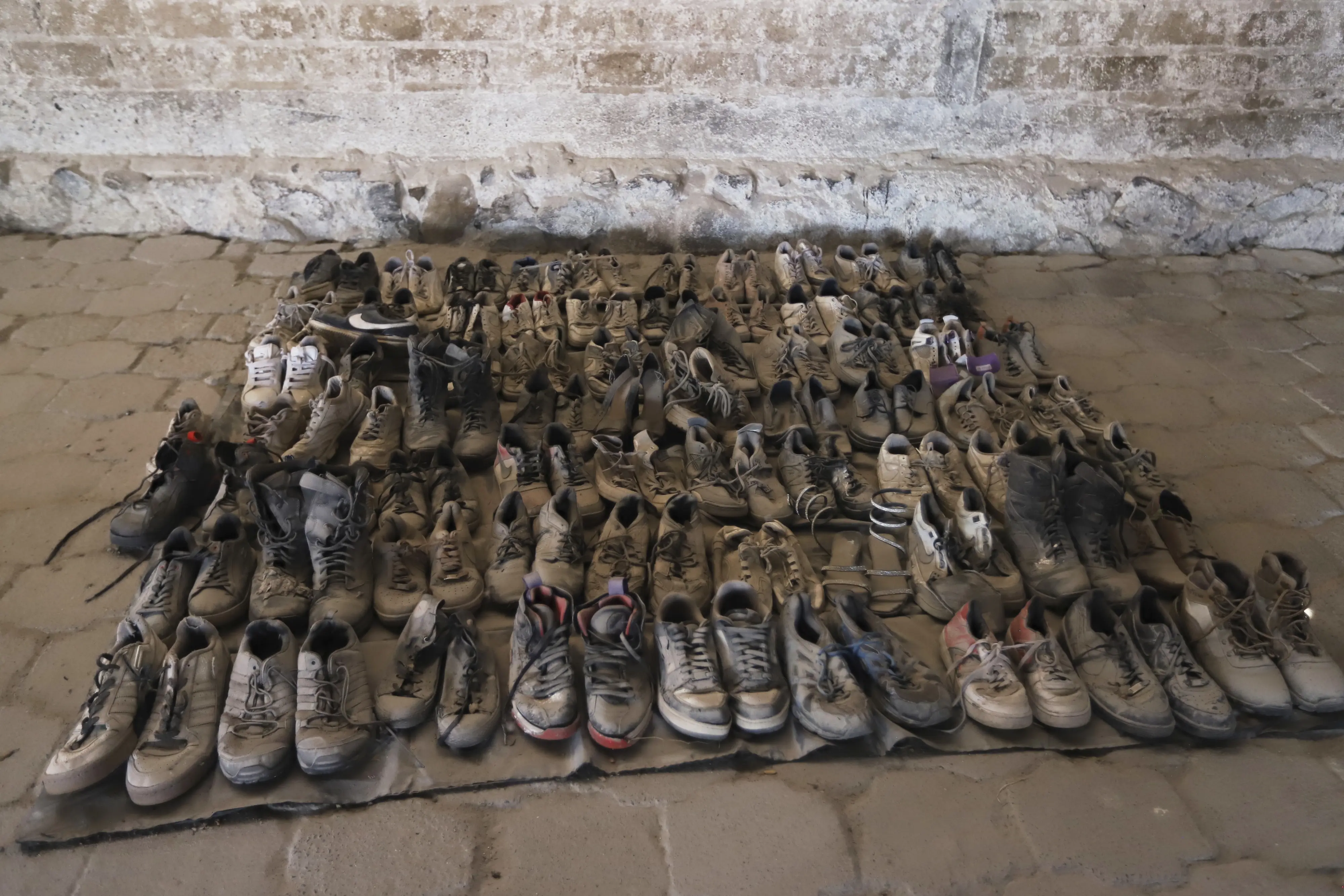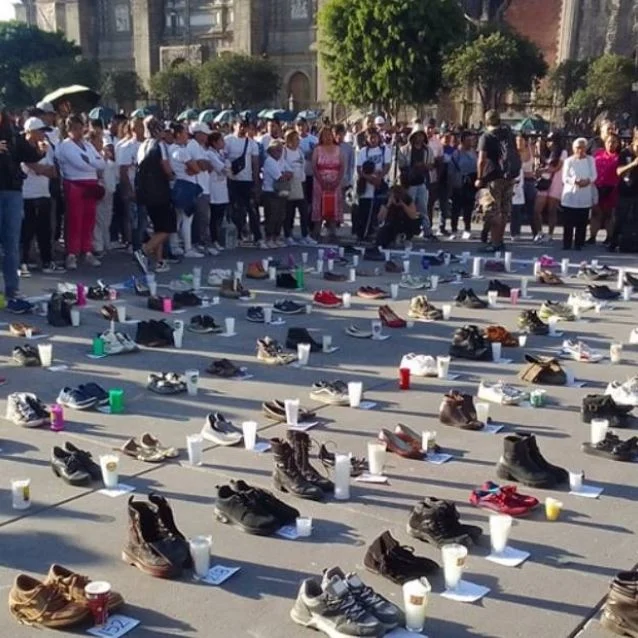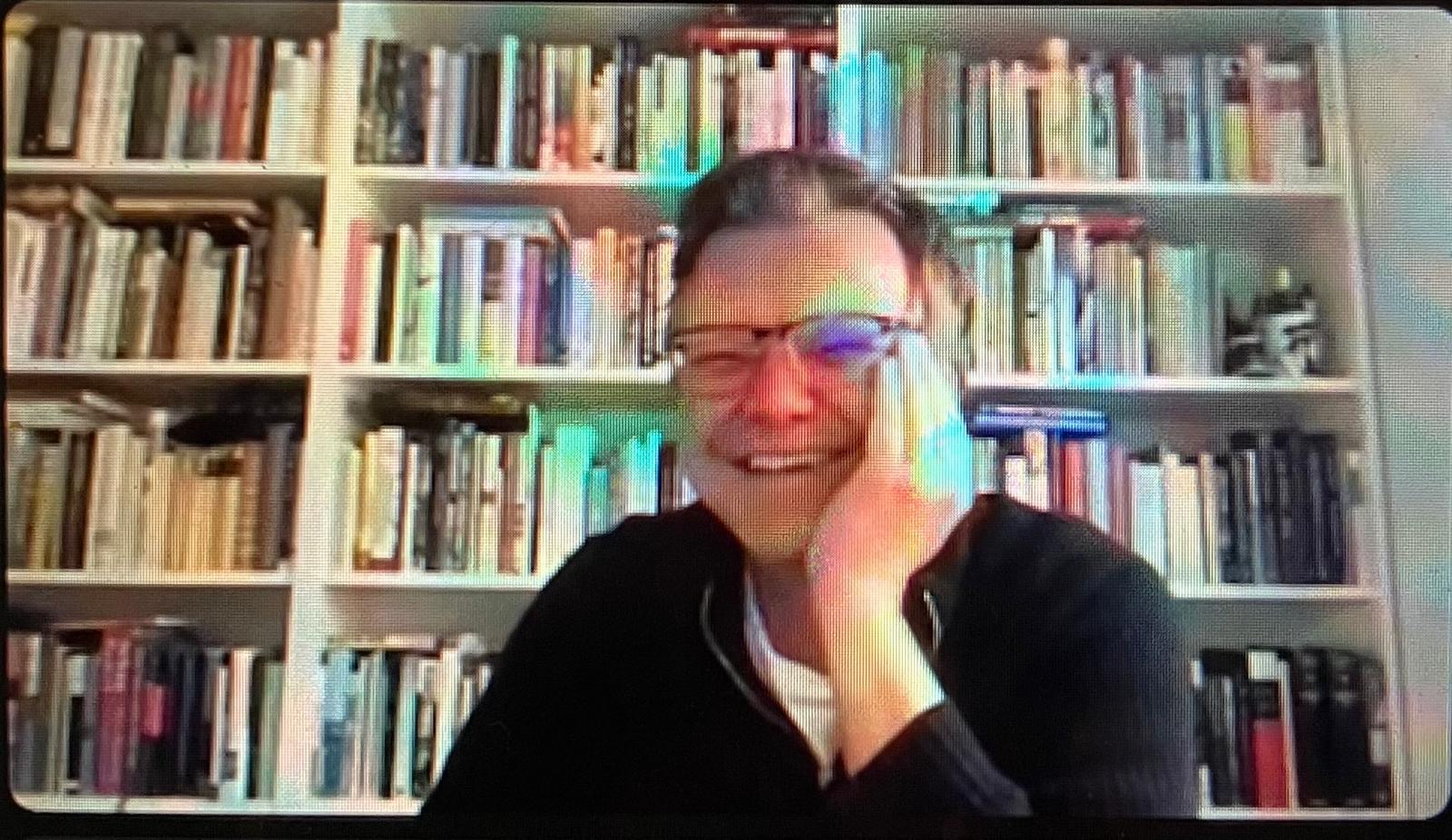“I curse your eyes, which do not know how to see.”
—Cristina Rivera Garza[1]
On 5 March 2025, Guerreros Buscadores, a collective of missing persons’ families who organise and search for their loved ones, breached the gates of Rancho Izaguirre in Teuchitlán, Jalisco, Mexico. What they uncovered was drawn from the marrow of horror: more than 1,300 fragments of clothing, bone, ash, and personal belongings—remnants of lives left to oblivion in what appears to be a narco-related killing camp.
Yet what persists, what continues to haunt, is an image (figure 1): tens of mud-stained shoes arranged in a forensic grid—not with precision, but with a carefulness that speaks of ritual absence. I have looked at this photograph for months now. I tried to turn away. I cannot.
I am writing because this photograph demands something that exceeds analysis. Looking at this image is to practice attention that resists the necropolitics of forgetting, moving on, letting the disappeared remain disappeared. This is not neutral ground. I write from within the wound, as a Latin American scholar navigating a personal and collective grieving process. Mexico has disappeared more than 121,000 people over the past two decades. This is not history. It is happening now, in the continuous present tense of violence.
I am approaching this image through what Paola Díaz calls “infrapolitical acts:” narrative-driven, collective, and emotion-generating actions against necropolitical assemblages—networks of state, criminal, and institutional violence that destroy not only bodies but also the cultural narratives conferring meaning upon them. The shoes in the grid are not just forensic evidence. They are fragments of stories necropolitics renders unwritten, unseen, and forgotten.

Figure 1. Image by the Jalisco state attorney general’s office shows shoes at Rancho Izaguirre, where skeletal remains were also found (photograph by Jalisco state attorney general’s office).
The grid and the gaze
The photograph presents dozens of shoes methodically arranged on a stone floor, with a weathered brick wall in the background. Work boots, athletic sneakers, casual shoes, high heels, all uniformly coated in beige dust that renders them almost monochromatic, almost abstract.
Even though the grid evokes forensic documentation, it simultaneously mobilizes tactility for resisting clinical detachment. Minor shifts in position (with some perfectly aligned, others slightly askew) signal absent bodies in interrupted motion, frozen mid-stride. These shoes were worn, lived in, contained by the living. They are the sole traces of life after the massacre.
In her analysis of the Colombian artist Doris Salcedo’s work, Jill Bennett theorizes such traces as the stuff of affective engagement: a bidirectional relation between art and audiences that moves both sensation and critical thought. Bennett understands material traces as “activating an affective connection as one senses the trace of human presence in an object.”[i] Salcedo’s Casa Viuda IV (1994-95) decontextualises domestic objects (furniture, clothing) by juxtaposing them with tactile human traces, provoking contemplation rather than shock. Everyday objects that survive massacre become haunted by the lives that habituated them. The objects become inhabited through perception, through trace.
I am framing this forensic photograph under a similar logic. In placing this forensic photograph in dialogue with Salcedo’s installations, I am not merely drawing a formal comparison but tracing a lineage of Latin American aesthetic practices that transmute the materials of mass death into spaces of public mourning. These traces are not metaphorical but material: frayed laces, worn soles, tongues collapsed from the weight of absent feet. The uniform dust connects individual shoes into a singular mass, yet their individuality persists despite necropolitical erasure.
Each shoe could belong to a loved one. A neighbour. You.
This relational collapse between viewer and victim is where the image’s affective power rests. Unlike graphic violence, which numbs, this minimalism confronts us with emptiness, staging an encounter with our own capacity to mourn.
Forensic aesthetics and the turn to evidence
I am also situating this photograph within what has been called the forensic turn in contemporary art and visual culture: a shift toward using evidentiary practices, material traces, and architectural analysis to bear witness to state violence and human rights violations.
Eyal Weizman’s Forensic Architecture has pioneered investigative techniques that use spatial analysis, material reconstruction, and crowd-sourced testimony to document violence that states aim to conceal. If Forensic Architecture’s power lies in its high-tech reconstructions that simulate events to make them legally legible, the power of the Teuchitlán image lies in its low-tech, indexical starkness. It does not simulate violence but presents its aftermath as an irreducible, material fact that demands an ethical, rather than purely legal, response. As Weizman (together with Thomas Keenan) argues in Mengele’s Skull, forensics is an inherently aesthetic practice which, through subtle gestures, methods of showing, and the shifts in form, allows things to emerge, to take shape, and to be seen in the world. The Teuchitlán photograph operates within this aesthetic regime. It is both document and monument, serving not only as evidence but also to mourn.[2]
Yet I approach it with caution. As Eray Çaylı notes in “Testifying to Violence Environmentally,” reflecting on our own methods not only as enablers of forensic testimony but also as implicated in the very ecologies where violence unfolds is essential. Such self-awareness cannot be peripheral to our work; it is part of a collective claim for justice. By analysing the image here, I contribute to its circulatory afterlife, a trajectory that strives to honour the disappeared and, at the same time, risks instrumentalising their absence for scholarly capital. The tension is inescapable: to write about the photograph is to make it legible within knowledge systems (visual culture discourse and publishing) that operate at considerable distance from the material conditions that produced it. My writing becomes part of the image’s political work, yes, but also part of its aesthetic consumption. I cannot resolve this complicity; I can only recognise it as the ethical condition of my engagement.
Still, I would like to believe that making the photograph legible as a demand for affective engagement in Bennett’s sense of the term differs from doing so in an exclusively forensic register. This demand avoids reducing the shoes featured in the photograph to specimens.
Mourning as labour
This photograph works. By working, I mean it performs cultural and political labour.
Following Erika Larsson, I approach mourning not as a passive emotion but as active work: the labour of looking, of assembling fragments, of holding the unbearable without rushing to closure. This is not the private, individualised grieving that modern Western culture prescribes, but social, political, communal mourning. It is the kind that searching collectives enact through the physical labour of unearthing remains, and that photographs extend into the public sphere.
Its forensic grid composition breaks down overwhelming horror into discrete units that can be confronted individually. Each shoe becomes a site where we can dwell, where the reality of specific absences can be acknowledged.
I imagined the lives lived in those shoes. All the love, loss, and hope a human life may bear. I grieved their loss in awe of their absence, envisioning their lost humanity as ground for reclaiming my Latin American identity, a constant-grieving ethos around our missing lives.
That said, this photograph does more than facilitate private grief. It converts individual trauma into a shared political project. Bennett writes that affectively driven material creates a spatial turn where one can experience objects through the senses, and this photograph specifically creates a space where “the capacity of vision to make sense of the world breaks down.”[3] We can no longer render present those who have disappeared. This labour of mourning, however, does not occur in a vacuum. It is a forced response to a specific political reality: Mexico’s necropolitical present.
Mexico’s necropolitical present
To understand the photograph’s political force and contextual entanglements, we must situate it within the specific necropolitical regime that produced it.
Mexico’s war on drugs, formalised in 2006, has resulted in over 400,000 deaths and 121,000 disappearances. This violence operates as per Mbembe’s concept of necropolitics: “the power and capacity to dictate who can live and who must die.”[4]
Clandestine graves have proliferated. Reports document 1,978 between 2006 and 2016. These graves materialise necropolitical assemblages: networks of power rendering victims’ bodies and identities invisible while preserving traces of their existence in unexpected configurations.
The Teuchitlán massacre exemplifies this regime. Unlike the 2014 Ayotzinapa massacre, where 43 disappeared students became internationally known and sparked protests using their names and visual identities, Teuchitlán’s victims largely lack names or individualised narratives. Grief-related resistance has relocated to visual aftermaths.
In this photograph, absence is mediated through objects victims left behind: shoes that refuse to decay, materialising absence while evidencing traces of lives.
Díaz argues that “when necropolitical assemblages make possible the disappearance of people, they produce anthropological violence, disassembling the foundations of a human form of death.”[5] This violence involves the intentional erasure of social life: preventing the construction of coherent biographical trajectories, disrupting intergenerational storytelling, and foreclosing public articulation of violence itself. Systems collapse under thousands of unidentified bodies and families face systematic fragmentation separating names from bodies, lives from stories.
The dust-covered shoes visually attempt to reassemble both physical remains and narrative coherence amid systematic erasure. Their persistent material presence is an infrapolitical act that confronts the necropolitics of complete disappearance. The contrast between forensic arrangement and the unfinished brick wall conjures an architectural frame evoking detention centres and clandestine killing sites. The shoes disturb this spatial order. Their material presence enacts residual gestures that recompose narratives as fragments within the silences of necropolitical assemblages.
This photograph functions as visual resistance as its power derives from affective engagement with material traces, simultaneously enacting bodily absence while affirming victims’ persistent social presence through emptied visuality and witness condition. But it does not stop there.
When the Grid Moves to the Streets
On 15 March 2025, just ten days after Guerreros Buscadores breached Rancho Izaguirre, activists arranged four hundred shoes in a grid formation at the Zócalo in Mexico City (figure 2). They placed a candle in front of every pair, directly referencing the Teuchitlán photographs while also scaling up from them. This protest exemplifies multidimensional memory: the transformation of documentary evidence into embodied collective ritual. The Teuchitlán images transcended their documentary-grieving function to become public memorials of history that include both image and memory itself. Ruiz Lagier has conceptualised commemorations that transform private grief into collective political labour as “antimonumentos:” political memory acts that contest the present through affective engagement by triggering contradictory emotions and affects, stretching from love to rage.

Figure 2. Zócalo’s Memorial Performance by Facebook Group Huellas de la memoria (photograph by Huellas de la memoria).
Antimonumentos represent a Latin American turn within anti-monumentalism. These are not static markers of past events, but acts of protest, spatial interruptions refusing the state’s narrative of closure. Emerging in spaces subjected to monumentalisation where power has long sought to inscribe its own permanence. Antimonumentos do not merely recall forced disappearances, femicides, massacres. They denounce. They demand. Their temporality is not that of a finished past but of an ongoing present, marked by absence, by impunity, by the state’s refusal to provide truth or reparation.
If the Teuchitlán photograph enacts the infrapolitical, the Zócalo reenactment constitutes an antimonumento: the manifestation of infrapolitics in shared, embodied space.
Judith Butler argues that photographs prevent forgetting; photography can help events achieve permanence and continuity. The Teuchitlán photograph becomes an example of this temporal insistence. Its forensic grid, seemingly a static documentation of absence, becomes an embodied and mutable symbol when reenacted in public spaces like the Zócalo.
This replication is not mimesis but deliberate infrapolitical gesture. By reconstructing the grid with hundreds of shoes, activists transform the image into participatory ritual, a collective performance of mourning refusing necropolitical logic of disappearance. Overall, the Zócalo performance defies mere representational logic. It becomes an event where activists mourn in the face of power, conjuring a politically charged place where memory is enacted, embodied, and grieved.
After their initial circulation, the Teuchitlán images gained power through repetition and recontextualisation. With each reenactment, layers of meaning are added, joining the massacre to broader social movements against impunity and state violence. Memorial actions in Mexico are conceived as battles for the present in a refusal to subsume collective trauma under dominant history. After all the shoes in the Zócalo are not artifacts tied to remembrance of a past event but evidence of an ongoing crisis, a visual insistence that the past is not past but a parallel, continuous timeline of grievance.
[1] Jill Bennett, Empathic Vision: Affect, Trauma, and Contemporary Art (Stanford: Stanford University Press, 2005), p.67.
[2] Eray Çaylı, “‘Accidental’ Encounters with the Ottoman Armenians in Contemporary Turkey,” Études arméniennes contemporaines 6 (2015): 257–270; Eray Çaylı, Earthmoving: Extractivism, War, and Visuality in Northern Kurdistan (Austin: University of Texas Press, 2025), pp.111-114.
[3] Bennett, Empathic Vision, pp.68–69.
[4] Achille Mbembe, Necropolitics, trans. Steven Corcoran (Durham: Duke University Press, 2019), p.17.
[5] Paola Díaz, “Assembling Stories of Disappearance in, Against and Beyond Necropolitical Assemblages,” Bulletin of Latin American Research 44, no. 2 (2025): 87–99.
Shoes arranged in a forensic grid at Rancho Izaguirre, where skeletal remains were found (photograph by Jalisco state attorney general’s office).
Álvaro Jose Chiriboga is a visual culture scholar based between Malmö (Sweden) and Quito (Ecuador). His research explores the intersections of necropolitics, forensic aesthetics, algorithmic violence, and digital neocolonialism in Latin America, examining how images act as agents of political resistance and affective connection. He is particularly interested in the work of contemporary Latin American women artists whose practices engage with social, emotional, and communal realities. Chiriboga holds an MA in Digital Culture and Society from King’s College London and is currently pursuing a master’s degree in Visual Culture at Lund University.
Álvaro Jose Chiriboga, “An embodied forensics?” JVC Magazine, 30 October 2025, https://journalofvisualculture.org/an-embodied-forensics/.





